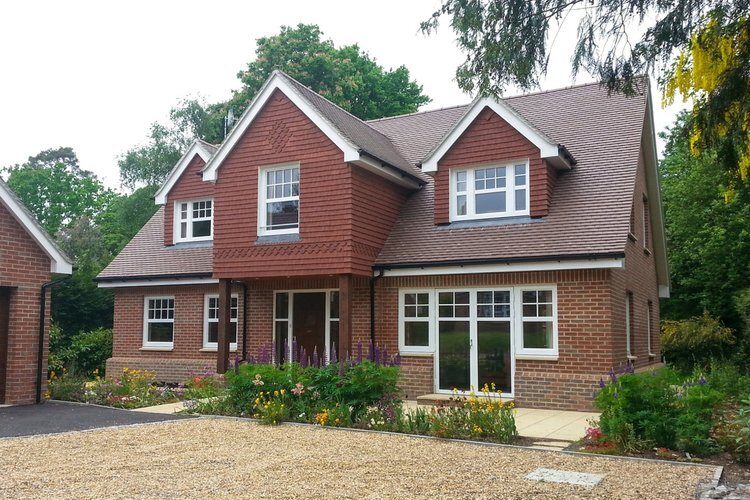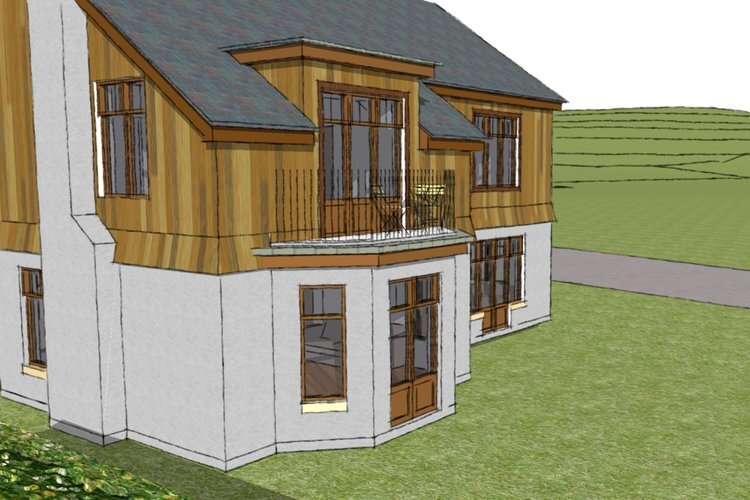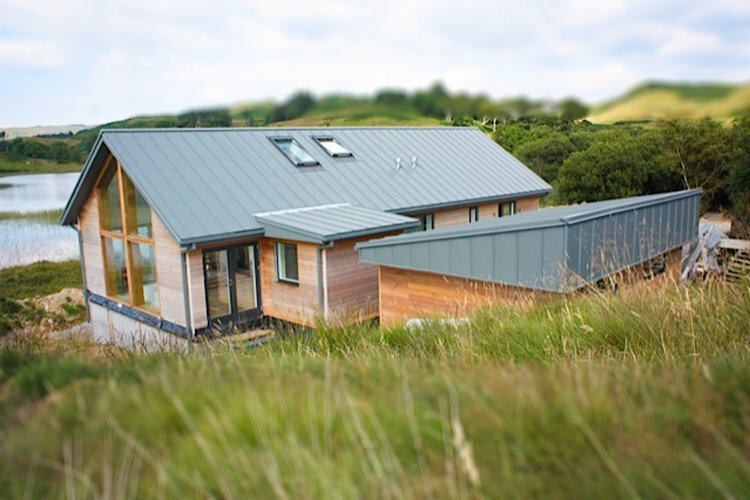Assessing Suitability: What Type of Land Can You Build On?
How to tell if a plot is suitable for your UK self build project
Welcome to our self build guide to plot appraisal. The journey of self building your own home in the UK is an exciting and complex process that merges practicality with personal vision. Each step, from conception to completion, carries its own set of challenges and opportunities. In our previous blog, Guide to Building Your Own Home in Scotland: Feasibility, we examined how to find a self build plot of land for creating your ideal home. Now, in this follow-up article, we'll examine why progressing through the process of assessing your plot with proper care and attention is so important for UK self builders.
Among all of the initial steps you'll undertake, appraising the viability and potential of your chosen self build plot is one of the most important. During this initial plot appraisal phase, you'll set the foundation for a successful project moving ahead, ensuring your ideal home aligns perfectly with its surrounding environment.
Chartered Architect and UK self building specialist, Philip Benton, explains:
When you find a nice building plot it can be tempting to get carried away with the vision for your new home and skip straight to making an offer to buy. Whilst making prompt contact with the seller is important, it’s vital to appraise the self build plot thoroughly before committing to a purchase, as this can save you time, money and stress later on.
Plot Appraisal helps you determine the constraints of a particular building plot, see its potential, and be aware of any issues or costs that may come up later in the build process. In this article, we'll examine how to successfully assess your desired plot using our detailed appraisal checklist, which covers the following key areas:
Details of Sale
Legal Restrictions
Access to Your Plot
Services Connections
Navigating Planning Permission for Your Building Plot
Flood Risk and Wildlife
Community Amenities and Services
However, before we dive into the checklist, let's go over some broader considerations you'll want to keep in mind as a self builder in Scotland or the wider UK.
How to find a plot of land for self build
In our Feasibility blog, we introduced the topic of how to find land to build a house in Scotland or the UK. The article covers the main steps for identifying the perfect self-build plot and addresses elements from availability to planning policy.
However, there is some additional information you'll want to keep in mind if you're planning a self-build, pertaining to certain types of developments and restrictions that may impact your choice of building plots.
Local planning authorities’ maps
As mentioned previously, when evaluating a self-build plot in the UK, it can be helpful to consult the local development plans of local authorities. These plans typically include a regional map outlining specific policies relevant to distinct areas.
This step can become an important part of an initial plot suitability assessment, because it enables you to determine if your desired plot lies within a green belt, conservation area, or other restrictive designations.
Understanding these designations assists in gauging building parameters. In rural locations, where specific maps might be lacking, check the planning policies on countryside housing and their relevance to residential development and self build plots.
Anticipating future area development
Understanding local planning policies not only helps gauge the feasibility of getting planning permission for your plot but also offers insight into potential future developments in surrounding areas. If views, privacy, or the outstanding natural beauty of the rural setting are major points of attraction, remember to keep in mind how the landscape might evolve in the years to come if neighbouring land is developed.
What type of land can you build on in the UK?
The land's history and the adjacent land use play a pivotal role in determining what potential development may be allowed. Brownfield sites and those adjacent to existing buildings tend to be much easier locations to get planning permission for development but generally come with more restrictions on the design.
Plots in UK greenfield areas are characterised by fewer surrounding structures and so can offer more design flexibility.
However, proximity to listed buildings or plots bordering conservation areas will heighten the need for designs that harmonise with the existing environment.
Navigating green belt land restrictions
Although green belt areas do have stringent construction limitations that can make obtaining planning permission challenging, there are certain exceptions that can prove helpful for enabling development:
Building conversions
Transforming existing structures, like unused barns, can be a feasible option when considering a self build plot within a green belt zone.
Another notable exception is the paragraph 80 clause (formerly paragraph 79 or PPS7) in planning law, which allows construction of a house in open countryside if the self build house design is of exceptional quality.
Although this presents a potential avenue for development in otherwise restricted areas, it's crucial to recognise the associated challenges and costs. Bear in mind, perceptions of ‘high-quality’ design might vary between homeowners and local council planning officers, which can impact the planning application's success.
Brownfield developments
Brownfield lands, previously developed areas, often provide a solid foundation for seeking new development permissions for a custom build. However, existing nearby structures, especially in towns or villages, can influence the planning department of the local council in terms of their perspective on what can be created. Such building plots might necessitate a design aligning with the scale, materials, and style of neighbouring buildings.
Environmental assessment and feasibility of building plots
When evaluating the suitability of a potential building plot, especially brownfield sites, understanding the environmental landscape is crucial. These sites can carry histories of land contamination as the term brownfield land often relates to residential development on land that was previously used for commercial or industrial purposes.
Simple investigative measures, such as enquiring informally with local councils or estate agents and researching the plot's history on old maps, can offer insights into potential risks. For instance, previously developed sites, such as those of former garages, industrial facilities, or even seemingly harmless establishments like sheep dips, could pose contamination risks. When an existing property is already present on the plot, understanding its history is essential.
Should there be concerns about past activities tainting the land of a potential self build plot, early soil testing becomes vital before securing it. This is paramount for self builders, given the significant costs and challenges of land remediation, which could entail removing substantial soil layers and replacing them - a process that can be costly and should influence any potential offer for a building plot on brownfield land.
The appraisal checklist: a detailed evaluation of your plot
Details of sale
Once you’ve found a plot that you’re interested in, contact the plot’s land owner, or estate agent if one has been appointed, to determine the details of the sale, when they would like to sell, and if there are any conditions for that. Often, it's also beneficial to reach out to local estate agents as they may have additional information about the plot or surrounding properties that could influence your decision.
Some plots require the installation of drainage, access or services before the sale can complete, so a sale will have to wait for that. In some cases these services may be shared between a number of plots, resulting in one sale being dependent on another.
Legal restrictions on self build plots
Look into any legal restrictions that are in place on the land. The seller should make you aware of these up front, and these will be confirmed by your solicitor later on if you proceed with the purchase. Restrictions include:
Easements - Rights by others to have access over your land to access their own.
Burdens - Obligations for you to do or not do certain things on your land, such as maintain boundary fences, not build on part of it, or allow neighbours to install pipes or cables across your land to service their own.
Overage - An agreement with a former owner to pay them a sum of money should the land be developed beyond (over) a pre agreed limit. For example, a piece of land may be sold as farmland, but require an additional payment should it ever be used for building houses.
Access to your plot of land
Self builders should check that you can access your plot directly from a public road. If your access is via another person's land or shared driveway you must confirm that you have a legal right to do that - not just an informal agreement. Evidence of that right will be needed should you ever wish to sell your home.
Beware of ‘Ransom Strips’. These are small strips of land - maybe a grass verge that separates a plot of land from a road. You may need permission from the owner to cross that strip, for which they can charge a fee - or ‘ransom’, Talk to the seller to clarify and your solicitor to confirm.
If your plot is far from a road, you may need the access to cater to large trucks for refuse collection, septic tank emptying, fuel delivery, and of course construction.
Services connections for building plots
Your plot will likely need an electricity supply, water, and wastewater/sewerage. You may also want a phone/broadband connection or mains gas (where available). Some plots will come with these pre-installed, saving you hassle and money. Others may need an application to be connected.
At the appraisal stage, self builders should contact utilities networks to determine how far it is to the nearest infrastructure, and confirm that there is sufficient capacity within the local network. Some networks will provide a free quotation for connection, others may charge you to provide a quotation.
If mains sewerage is not available locally you will need to install a septic tank and soakaway or alternative form of treatment within your plot. Be aware of the space required for these, as they can be quite big.
If ground conditions don’t have sufficient percolation for a soakaway to work (e.g. clay soil) you may need to direct treated waste water towards a watercourse. SEPA will have to approve this discharge arrangement, as will any landowners whose land the water/pipe crosses.
Navigating planning permission for your self-build
Assuming your chosen plot comes with some form of Planning Permission, the next task is determining whether it aligns with the house you envision building. For instance, existing planning permission for a small bungalow doesn’t necessarily mean you'll be given permission for a large two-story house, and vice versa.
Planning consent depends on factors like local authority policy, neighbouring structures, site history, and any prior permissions. An experienced self-build architect can help navigate issues specific to your site's planning permission and advise on a house design that's likely to gain approval from the Planning Department. Additionally, they can field questions regarding build cost and ensure the design accommodates the plot, your personality, and lifestyle.
As discussed in our earlier Feasibility Guide, for those venturing into a self-build project in the UK, it's crucial to grasp the subtleties of planning permission. Plots may come with either outline (‘planning permission in principle’) or full / detailed planning permission. The former signals general planning consent for building but doesn’t delve into design specifics. The latter, detailed planning permission, pertains to an approved house design that can, in certain circumstances, be revisited.
As mentioned, when entertaining a plot without planning permission, it's advisable to consult your local Planning Department, providing site plans and photos to ascertain potential approval during the Feasibility stage. Though some departments do extend initial ‘pre-application advice’ on a complimentary basis, be mindful that fees might apply.
For guidance, especially in complicated or contentious scenarios, hiring a planning consultant can be an invaluable step in ensuring a smoother application process and expert advice.
For additional information on planning applications and permission pertaining to self build mortgages, refer to our Guide To Building Your Own Home in Scotland: Feasibility.
Other points to consider when evaluating plot suitability
Evaluating the flood risk of your building plot
Understanding flood risk is paramount when assessing a building plot. In Scotland, SEPA (Scottish Environmental Protection Agency) provides flood maps on their website, while in England and Wales, it's the Environment Agency. These tools can indicate if your plot lies in a flood-risk zone. If so, it's crucial to proceed with caution and consult an expert for guidance.
Wildlife considerations for self build plots
Environmental considerations for building plots also extend to wildlife and protected species. Those located near natural habitats might come with unique challenges. Early consultations with the local planning authority can shed light on potential concerns, as they'll be aware of any protected species in the area. Especially when dealing with older structures, like barn conversions, specific surveys for nesting bats or birds might be necessary.
It's essential to understand that such surveys can only be carried out at certain times of year, potentially impacting your project timeline. While management solutions, such as alternative nesting boxes, often address these concerns, in rare instances, the presence of protected species might hinder development. However, most challenges can be managed with the right approach.
Considering community, amenities and essential services
When plot hunting and evaluating a piece of land as a potential self build home location, it's essential to look beyond the plot itself and to consider the broader community and amenities. Rural areas, while offering peaceful outlooks and connection to nature, often come with the trade-off of increased dependence on vehicles due to fewer nearby facilities. This limitation can affect choices in shops, schools, community events, and other essential services.
Additionally, be sure to consider the proximity to emergency and healthcare services, as these can be an important consideration in secluded or remote settings. Before committing to your perfect plot, weigh the balance between tranquillity and access, and determine if the available amenities and services align with your lifestyle and needs.
Schools and planning for retirement
For families, school catchment areas play a pivotal role in home location decisions. Local authority websites provide information on school zones.
Moreover, if you're considering a location for retirement, think ahead about future mobility and care requirements. As we age, having amenities within walking distance or accessible via public transport can be crucial.
Engaging all parties
Though you may hold the central role in decision-making, it's important to integrate feedback from every family member who will reside in the home. Gathering insights from all involved parties can help guarantee that the selected plot aligns with everyone's expectations, promoting an optimal living environment.
Concluding thoughts on how to find land to build a house, UK
Embarking on the path of self building your own home is not just about construction, it's an exciting journey about realising your personal vision and facilitating an optimal living environment for yourself and your family. Central to this process is plot appraisal, a foundational step that will inform many other decisions along the way.
Every UK self build plot holds a unique blend of challenges and possibilities waiting to be discovered. Through detailed planning and research, you're not only setting the stage for a successful self build journey, but also ensuring that your project progresses smoothly and that the end result aligns with your personal aesthetic, needs and values. As you navigate the process of finding your perfect plot, remember that each step you take is one closer to realising your dream home and embrace your project with a mixture of careful attention and enthusiasm.
If you are thinking about self-building in Scotland and have any questions, or if you're exploring potential building plots in the UK, feel free to contact us for advice on 0845 508 2823 or on our contact page.
For more detailed information about planning your project and working with an architect, please read our Homeowner Guide: How Much Should an Architect Cost?
More: How to Choose A Self-Build Architect - Questions to Ask, and One Not To
Self Build Case Studies:
This article is intended as general advice only, and should not be relied upon for key decisions without taking professional advice specific to your project.








